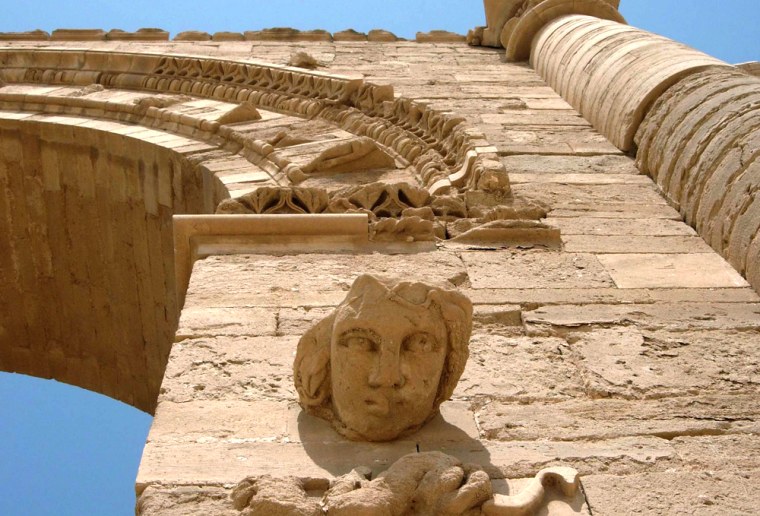Over 2,000 years ago this thriving Mesopotamian oasis city welcomed caravans of camels carrying travelers between East and West, twice held back Roman invaders, and was famous for its tolerance of different religions.
Now Hatra sits in ruins in a vast desert. Parts of its giant temples, columns and arches are still standing under the incessant sun but its city center is probably visited by more rabbits than people. Around it stands a nation still struggling to heal ancient grievances between feuding religious and ethnic groups, hoping to revisit high points in its history where the roots of civilization once sprouted.
The United Nations has declared it a world heritage site, but few people these days risk journeying to the ruins, 200 miles north of Baghdad.
Most visitors are guests of the U.S. military, and a handful of Iraqi guards protect the site. Most of the wire fence surrounding it has collapsed, but a girl in a bright dress is still on hand to dutifully raise a gate for a visiting convoy of Humvees.
Inside the circular city stand several largely intact temples to ancient gods, including a stone shrine over two stories high, dedicated to Shamash, the sun god. Although many relics and statues were rushed away to museums in Baghdad and Mosul during the 2003 invasion, a statue of a robed woman, possibly a king’s wife, still stares down at visitors.
Inscriptions in Aramaic, the language once spoken by Christ, are still visible on some buildings.
After the U.S.-led invasion in 2003, looters shot and damaged decorated features on Hatra’s walls, McGuire Gibson, an archaeology professor at the University of Chicago, said in an e-mail.
“The site is wonderful to walk around in, especially late in the evening and early in the morning,” he said. “It is amazing that such a large city could exist where it does, dependent on cisterns and ground water.”
Gibson was on a U.N. team that investigated stolen or damaged Iraqi antiquities after the war.
“Probably the worst damage was caused by the exploding of munitions by U.S. forces,” he said.
Gibson said the military eventually diminished the blasts, which were threatening to destabilize buildings in Hatra, but continued detonating explosives in the area.
Despite the turmoil, glimpses of the city’s mixed East-West architecture of Roman, Hellenistic and Parthian styles testify to the diverse tradesmen and travelers who once passed through.
“The significance of Hatra as a bridge between East and West is plain for all to see,” Roberta Ricciardi Venco, a professor at Turin University in Italy who has conducted surveys and excavations in the city, said in an e-mail.
The city’s two defensive walls remain visible, including the outer one of clay that is over 3 miles long. More than 150 closely spaced towers helped Hatra withstand Roman attack in the second century A.D., according to a guide provided by the U.S. military, but the city eventually fell to the Sassanid empire of what is now Iran.
Hatra’s novelty is its largely unexcavated condition. Dozens of unfinished digs lie outside the inner wall of the city, showing sand-covered shapes that leave visitors wondering about what lies beneath.
The site is also recognized by film buffs as the opening scene of the classic movie “The Exorcist,” in which an aging priest finds a relic that signals he will soon face an evil that turns out to be a demonically possessed girl.
Iraq’s recent tortured history is also on display. In the 1990s Saddam Hussein started to reconstruct parts of the site — but ordered that bricks stamped with his name be used.
A handful of bullet casings lined some temple floors and U.S. Black Hawk helicopters swooped above. Though U.S.-led forces have brought relative calm to this rural area, guards warned of insurgents in the distance.
U.S. soldiers said grants were allocated after the invasion to lure tourists to the site, but a nearby hotel now serves as an Iraqi Army base. Archaeologists say they don’t expect to be back soon.
“You’ve got to be kidding. I know of no archaeologist who would think of visiting the site right now,” said Gibson.
